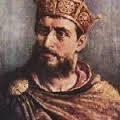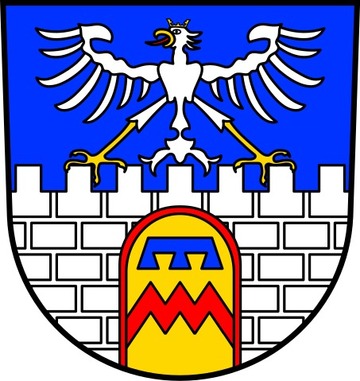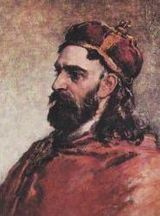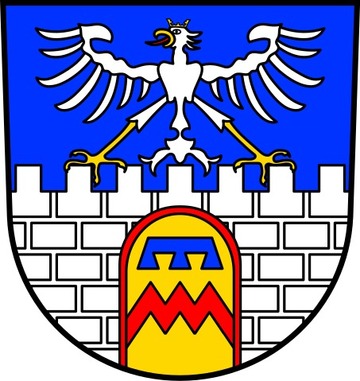maximum test » Ezzo "aka Ehrenfried (Erenfried) (von BONNGAU) von RHEINPFALZ; aka Ezzo of the RHINE; von LOTHRINGEN" (± 955-1034)
Persoonlijke gegevens Ezzo "aka Ehrenfried (Erenfried) (von BONNGAU) von RHEINPFALZ; aka Ezzo of the RHINE; von LOTHRINGEN"
Bronnen 1, 2- Roepnaam is aka Ehrenfried (Erenfried) (von BONNGAU) von RHEINPFALZ; aka Ezzo of the RHINE; von LOTHRINGEN.
- Hij is geboren rond 955 in Duisburg, Nordrhein-Westfalen, Duitsland.
- Beroepen:
- Pfalzgreve.
- unknown in Count of Lorraine.
- Comte palatin, de Bonngau, d'Auelgau.
- Conde Paladino da Lotharingia.
- Woonachtig: Duitsland.
- Hij is overleden op 21 maart 1034 in Saalfeld,Mulhausen,Thüringen,Duitsland.
- Hij is begraven in het jaar 1034Brauweiler
Rhineland-Palatinate Duitsland. - Een kind van Herman Count Palatine of Lotharingia Count Palatine of Lotharingia en Heilwig von Dillingen
- Deze gegevens zijn voor het laatst bijgewerkt op 12 mei 2019.
Gezin van Ezzo "aka Ehrenfried (Erenfried) (von BONNGAU) von RHEINPFALZ; aka Ezzo of the RHINE; von LOTHRINGEN"
Hij is getrouwd met Mathilde.
Zij zijn getrouwd in het jaar 998 te Lorraine,Alsace,France.
Kind(eren):
Notities over Ezzo "aka Ehrenfried (Erenfried) (von BONNGAU) von RHEINPFALZ; aka Ezzo of the RHINE; von LOTHRINGEN"
Name Suffix:Count Palatine Of Lorrain
Ezzo eller ?Ehrenfried? var pfalzgreve i Lothringen.
Han stammet fra en greveslekt som bodde i Bonnregionen. Hans far var i det 10.
århundre i besittelse av det lothringske Pfalz-grevskapet. Dette sto i forbindelse med Pfalz i
Achen.
Ezzo hadde eiendommer i Thüringen og Østfranken og nevnes først som pfalzgreve i
dokumenter fra 1020. Han opptråtte på Otto III's side.
Ezzo døde på sin eiendom Saalfeld etter sigende ca. 90 år gammel.
Ezzo
From Wikipedia, the free encyclopedia
Ezzo (circa 955 – 21 March 1034), sometimes called Erenfried, Count Palatine of Lotharingia of the Ezzonen dynasty, was the son of Herman I.
Having married Matilda of Saxony (died 1025), a daughter of Emperor Otto II and Theophanu, Ezzo became prominent during the reign of his brother-in-law, Emperor Otto III. His power was increased due to the liberal grant of lands in Thuringia and Franconia which his wife received out of Ottonian possessions. Candidate to the imperial throne at the death of Otto III, he received huge territories (Kaiserswerth, Duisburg, and Saalfeld) for renouncing to the throne, making him the most powerful man in the empire after the emperor. Otto's successor, Emperor Henry II, was less friendly towards the powerful count, although there was no serious trouble between them until 1011. Some disturbances in Lotharingia quickly forced the emperor to come to terms, and Ezzo's assistance was purchased with additional imperial fiefs.
After this, the relations between Henry and his vassal appear to have been satisfactory. Very little is known about Ezzo's later life, but we are told that he died at a great age at Saalfeld on 21 March 1034.
Ezzo founded the Brauweiler Abbey near Keulen, the place where his marriage had been celebrated. It was dedicated in 1028 by Piligrim, archbishop of Keulen. Ezzo and his wife were buried at Brauweiler.
[edit] Children
He and Mathilda left three sons and seven daughters:
Liudolf (c. 1000–10 April 1031), Count of Zütphen.
Otto I (died 1047), Count Palatine of Lotharingia and later Duke of Swabia as Otto II.
Hermann II (995–1056), Archbishop of Keulen.
Theophanu (died 1056), Abbess of Essen and Gerresheim.
Richeza of Lotharingia (died 21 March 1063), Queen of Poland, married with King Mieszko II of Poland.
Adelheid (died c. 1030), Abbess of Nijvel (Nivelles).
Heylwig, Abbess of Neuss.
Mathilde, Abbess of Dietkirchen and Villich.
Sophie, Abbess of St. Maria, Mainz.
Ida (died 1060), Abbess in Keulen and Gandersheim (Abbey founded in 852 by her ancestor Liudolf, Duke of Saxony).
[edit] Sources
Kimpen, E., ‘Ezzonen und Hezeliniden in der rheinischen Pfalzgrafschaft’, Mitteilungen des Österreichischen Instituts für Geschichtsforschung. XII. Erg.-Band. (Innsbruck 1933) S.1-91.
Lewald, Ursula, 'Die Ezzonen. Das Schicksal eines rheinischen Fürstengeschlechts', Rheinische Vierteljahrsblätter 43 (1979) S.120-168
Steinbach, F., ‘Die Ezzonen. Ein Versuch territorialpolitischen Zusammenschlusses der fränkischen Rheinlande’, Collectanea Franz Steinbach. Aufsätze und Abhandlungen zur Verfassungs-, Sozial- und Wirtschaftsgeschichte, geschichtlichen Landeskunde und Kulturraumforschung, ed. F. Petri en G. Droege (Bonn 1967) S.64-81.
Van Droogenbroeck, F.J., ‘Paltsgraaf Herman II (†1085) en de stichting van de abdij van Affligem (28 juni 1062)’, Jaarboek voor Middeleeuwse Geschiedenis 2 (Hilversum 1999) S.38-95.
Van Droogenbroeck, F.J., ‘De betekenis van paltsgraaf Herman II (1064-1085) voor het graafschap Brabant’, Eigen Schoon en De Brabander 87 (Brussels 2004) S.1-166.
Ancestral Roots of Certain American Colonists Who Came to America Before 1700 by Frederick Lewis Weis, Lines: 147-21, 147A-21, 147-22
The Plantagenet Ancestry of King Edward III and Queen Phillippa by George Andrews Moriarty
Preceded by
Hermann I Count Palatine of Lotharingia
1015–1034 Succeeded by
Otto I
Hezzelin I
From Wikipedia, the free encyclopedia
Jump to: navigation, search
Hezzelin I (also called Hezilo or Hermann), count in Zulpichgau died 1033), son of count palatine Hermann I of Lotharingia.
He married a daughter of Duke Conrad of Carinthia and had at least two sons:
Heinrich I "Furiosus", count palatine of Lotharingia from 1045 until 1060;
Conrad III of Zulpichgau, Duke of Carinthia from 1056 until 1061 (died 1061).
{geni:about_me} - http://en.wikipedia.org/wiki/Ezzo,_Count_Palatine_of_Lotharingia
- http://www.rheinische-geschichte.lvr.de/Persoenlichkeiten/ezzo-/DE-2086/lido/57c6a72fc81e80.76712142
- http://fmg.ac/Projects/MedLands/LOTHARINGIA.htm#Ezzodied1034
1. EZZO [Ehrenfried] (-Saalfeld 21 May 1034, bur Brauweiler). The Brunwilarensis Monasterii Fundatio names "Herenfridus comes palatinus, qui post Ezo nominatus est" as husband of "Mathilde filia Magni Ottonis", and in a later passage as son of "Hermanni comitis palatine…cognomente Pusillus"[345]. Graf in Auelgau: Emperor Heinrich II donated property of "Willihelmus comes et Boppo frater eius in villa Winetre in pago Auelgouue in comitatu Ezzonis comitis" to Kloster St Petrus at Bonn by charter dated 25 Feb 1015[346]. Pfalzgraf... ...
---------
------------
-----------
http://finnholbek.dk/getperson.php?personID=I15277&tree=2
Other names for Ezzo were Ehrenfried and Ezzo of Palatine.
General Notes:
Ezzo eller var pfalzgreve i Lothringen.
Han stammet fra en greveslekt som bodde i Bonnregionen. Hans far var i det 10. århundre i besittelse av det lothringske Pfalz-grevskapet. Dette sto i forbindelse med Pfalz i Achen.
Ezzo hadde eiendommer i Thüringen og Østfranken og nevnes først som pfalzgreve i dokumenter fra 1020. Han opptråtte på Otto III's side.
Ezzo døde på sin eiendom Saalfeld etter sigende ca. 90 år gammel.
Research Notes:
Ezzo or Ehrenfried (c. 954 - March 21, 1024), count palatine in Lorraine, was the son of a certain Hermann (d. c. 1000), also a count palatine in Lorraine who had possessions in the neighbourhood of Bonn.
Having married Matilda (d. 1025), a daughter of the emperor Otto II, Ezzo came to the front during the reign of his brother-in-law, the emperor Otto III. (983-1002); his power was increased owing to the liberal grant of lands in Thuringia and Franconia which he received with his wife, and some time later his position as count palatine was recognized as an hereditary dignity. Otto's successor, the emperor Henry II, was less friendly towards the powerful count palatine, though there was no serious trouble between them until 1011; but some disturbances in Lorraine quickly compelled the emperor to come to terms, and the assistance of Ezzo was purchased by a gift of lands.
Henceforward the relations between Henry and his vassal appear to have been satisfactory. Very little is known about Ezzo's later life, but we are told that he died at a great age at Saalfeld on the 21st of March 1024. He left three sons, among them being Hermann, who was archbishop of Keulen from 1036 to 1056, and Otto, who was for a short time duke of Swabia; and seven daughters, six of whom became abbesses. Ezzo founded a monastery at Brauweiler near Cologne, the place where his marriage had been celebrated. This was dedicated in 1028 by Piligrim, archbishop of Keulen, and here both Ezzo and his wife were buried. 3
Noted events in his life were:
• He was a Count Palatine.
--------------------
Biografi - Biography
Ezzo eller «Ehrenfried» var pfalzgreve i Lothringen.
Han stammet fra en greveslekt som bodde i Bonnregionen. Hans far var i det 10. århundre i besittelse av det lothringske Pfalz-grevskapet. Dette sto i forbindelse med Pfalz i Achen.
Ezzo hadde eiendommer i Thüringen og Østfranken og nevnes først som pfalzgreve i dokumenter fra 1020. Han opptråtte på Otto III's side.
Ezzo døde på sin eiendom Saalfeld etter sigende ca. 90 år gammel. 1
1.
Allgemeine deutsche Biographie. Mogens Bugge: Våre forfedre, nr. 36. Bent og Vidar Billing Hansen: Rosensverdslektens forfedre, side 67, 80.
--------------------
Lothrangian Count Palatine
http://www.nationmaster.com/encyclopedia/Ezzo
--------------------
Ezzo (c. 955 – 21 March 1034), sometimes called Erenfried, Count Palatine of Lotharingia of the Ezzonen dynasty, was the son of Herman I.
Having married Matilda of Duitsland (died 1025), a daughter of Emperor Otto II and Theophanu, Ezzo became prominent during the reign of his brother-in-law, Emperor Otto III. His power was increased due to the liberal grant of lands in Thuringia and Franconia which his wife received out of Ottonian possessions. Candidate to the imperial throne at the death of Otto III, he received huge territories (Kaiserswerth, Duisburg, and Saalfeld) for renouncing to the throne, making him the most powerful man in the empire after the emperor. Otto's successor, Emperor Henry II, was less friendly towards the powerful count, although there was no serious trouble between them until 1011. Some disturbances in Lotharingia quickly forced the emperor to come to terms, and Ezzo's assistance was purchased with additional imperial fiefs.
After this, the relations between Henry and his vassal appear to have been satisfactory. Very little is known about Ezzo's later life, but we are told that he died at a great age at Saalfeld on 21 March 1034.
Ezzo founded Brauweiler Abbey near Keulen, the place where his marriage had been celebrated. It was dedicated in 1028 by Piligrim, archbishop of Keulen. Ezzo and his wife were buried at Brauweiler.
[edit]Children
He and Mathilda left three sons and seven daughters:
Liudolf (c. 1000–10 April 1031), Count of Zütphen.
Otto I (died 1047), Count Palatine of Lotharingia and later Duke of Swabia as Otto II.
Hermann II (995–1056), Archbishop of Keulen.
Theophanu (died 1056), Abbess of Essen and Gerresheim.
Richeza of Lotharingia (died 21 March 1063), Queen of Poland, married with King Mieszko II of Poland.
Adelheid (died c. 1030), Abbess of Nijvel (Nivelles).
Heylwig, Abbess of Neuss.
Mathilde, Abbess of Dietkirchen and Villich.
Sophie, Abbess of St. Maria, Mainz.
Ida (died 1060), Abbess of Keulen and Gandersheim Abbey (founded in 852 by her ancestor Liudolf, Duke of Saxony).
[edit]Sources
Kimpen, E., ‘Ezzonen und Hezeliniden in der rheinischen Pfalzgrafschaft’, Mitteilungen des Österreichischen Instituts für Geschichtsforschung. XII. Erg.-Band. (Innsbruck 1933) S.1-91.
Lewald, Ursula, 'Die Ezzonen. Das Schicksal eines rheinischen Fürstengeschlechts', Rheinische Vierteljahrsblätter 43 (1979) S.120-168
Steinbach, F., ‘Die Ezzonen. Ein Versuch territorialpolitischen Zusammenschlusses der fränkischen Rheinlande’, Collectanea Franz Steinbach. Aufsätze und Abhandlungen zur Verfassungs-, Sozial- und Wirtschaftsgeschichte, geschichtlichen Landeskunde und Kulturraumforschung, ed. F. Petri en G. Droege (Bonn 1967) S.64-81.
Van Droogenbroeck, F.J., ‘Paltsgraaf Herman II (†1085) en de stichting van de abdij van Affligem (28 juni 1062)’, Jaarboek voor Middeleeuwse Geschiedenis 2 (Hilversum 1999) S.38-95.
Van Droogenbroeck, F.J., ‘De betekenis van paltsgraaf Herman II (1064-1085) voor het graafschap Brabant’, Eigen Schoon en De Brabander 87 (Brussels 2004) S.1-166.
Ancestral Roots of Certain American Colonists Who Came to America Before 1700 by Frederick Lewis Weis, Lines: 147-21, 147A-21, 147-22
The Plantagenet Ancestry of King Edward III and Queen Phillippa by George Andrews Moriarty
Preceded by
Hermann ICount Palatine of Lotharingia
1015–1034Succeeded by
Otto I
--------------------
Ezzo (circa 955 – 21 March 1034), sometimes called Erenfried, Count Palatine of Lotharingia of the Ezzonen dynasty, was the son of Herman I.
Having married Matilda of Saxony (died 1025), a daughter of Emperor Otto II and Theophanu, Ezzo became prominent during the reign of his brother-in-law, Emperor Otto III. His power was increased due to the liberal grant of lands in Thuringia and Franconia which his wife received out of Ottonian possessions. Candidate to the imperial throne at the death of Otto III, he received huge territories (Kaiserswerth, Duisburg, and Saalfeld) for renouncing to the throne, making him the most powerful man in the empire after the emperor. Otto's successor, Emperor Henry II, was less friendly towards the powerful count, although there was no serious trouble between them until 1011. Some disturbances in Lotharingia quickly forced the emperor to come to terms, and Ezzo's assistance was purchased with additional imperial fiefs.
After this, the relations between Henry and his vassal appear to have been satisfactory. Very little is known about Ezzo's later life, but we are told that he died at a great age at Saalfeld on 21 March 1034.
Ezzo founded the Brauweiler Abbey near Keulen, the place where his marriage had been celebrated. It was dedicated in 1028 by Piligrim, archbishop of Keulen. Ezzo and his wife were buried at Brauweiler
He and Mathilda left three sons and seven daughters:
Liudolf (c. 1000–10 April 1031), Count of Zütphen.
Otto I (died 1047), Count Palatine of Lotharingia and later Duke of Swabia as Otto II.
Hermann II (995–1056), Archbishop of Keulen.
Theophanu (died 1056), Abbess of Essen and Gerresheim.
Richeza of Lotharingia (died 21 March 1063), Queen of Poland, married with King Mieszko II of Poland.
Adelheid (died c. 1030), Abbess of Nijvel (Nivelles).
Heylwig, Abbess of Neuss.
Mathilde, Abbess of Dietkirchen and Villich.
Sophie, Abbess of St. Maria, Mainz.
Ida (died 1060), Abbess in Keulen and Gandersheim (Abbey founded in 852 by her ancestor Liudolf, Duke of Saxony).
--------------------
http://de.wikipedia.org/wiki/Ezzo_%28Lothringen%29
Ezzo (Lothringen)
aus Wikipedia, der freien Enzyklopädie
Wechseln zu: Navigation, Suche
Erenfrid (genannt: Ezzo) (* um 955 in Lothringen; † 21. Mai 1034 in Saalfeld/Thüringen) war Pfalzgraf von Lothringen. Für ihn finden sich auch die verkleinernden Schreibweisen "Ezelin", "Hezelin", "Hezelo" bzw. "Hezilo". Seine Nachfahren heißen Ezzonen.
Inhaltsverzeichnis
[Anzeigen]
* 1 Leben
* 2 Nachkommen
* 3 Literatur
* 4 Weblinks
Leben [Bearbeiten]
Die Eltern von Ezzo waren Pfalzgraf Hermann I. von Lothringen († 996) und Heylwig/Heilwig von Dillingen. Ezzo heiratete Mathilde (um 979–1025), die Tochter des Kaisers Otto II..
Um eine standesgemäße Versorgung der Kaisertochter zu sichern, erhielt Ezzo zahlreiche Grafschaften und Vogteien, unter anderem den Auelgau oder die Waldenburg im Sauerland, aber auch die Reichsdomäne Saalfeld und den Orlagau, zu dem damals auch die Gebiete südwestlich von Saalfeld bis zum Gebirgskamm gehörten.
Er kontrollierte die großen Fernwege, z.B. mit Hilfe der Tomburg bei Rheinbach (ab 1000) und des Siegburger Michaelsberges. Damit begann ein Machtkampf mit dem Erzbistum Köln.
1024 gründeten die Eheleute das Benediktinerkloster Brauweiler, in dem beide auch beigesetzt sind.
Nachkommen [Bearbeiten]
Aus der Ehe mit Mathilde sind zehn Kinder hervorgegangen:
* Hermann II. (995–1056), Erzbischof von Köln von 1035 bis 1056.
* Richeza (um 994–1063), 1013 verheiratet mit Mieszko II. Lambert, König von Polen († 1034).
* Ludolf von Brauweiler und Waldenburg (um 998–1031).
* Otto (um 998–1047), Pfalzgraf von Lothringen 1035–1045 und Herzog von Schwaben zwischen 1045 und 1047.
* Adelheid, Stiftsdame, möglicherweise Äbtissin von Nijvel (Nivelles).
* Ida, Äbtissin von Maria im Capitol in Köln und von Stift Gandersheim.
* Theophanu, Äbtissin von Stift Essen und Stift Gerresheim.
* Heylwig/Heilwig, Äbtissin von Neuss, Vilich und Dietkirchen (gegenüber Vilich auf der anderen Rheinseite)
* Sophia/Sophie († vor 1031)
* Mathilde, Äbtissin von Dietkirchen und Vilich.
Literatur [Bearbeiten]
* Theodor Henner: Ezzo. In: Allgemeine Deutsche Biographie (ADB). Band 6. Duncker & Humblot, Leipzig 1877, S. 465 f.
* Ezzo (Lothringen). In: Biographisch-Bibliographisches Kirchenlexikon (BBKL).
Weblinks [Bearbeiten]
* Ezzo bei genealogie-mittelalter
Vorgänger Amt Nachfolger
Hermann I. Pfalzgraf von Lothringen
1015–1034 Otto
Normdaten: PND: 124283209 – weitere Informationen
Diese Seite wurde zuletzt am 8. September 2009 um 20:28 Uhr geändert.
--------------------
Ezzo (circa 955 – 21 March 1034), sometimes called Erenfried, Count Palatine of Lotharingia of the Ezzonen dynasty, was the son of Herman I.
Having married Matilda of Saxony (died 1025), a daughter of Emperor Otto II and Theophanu, Ezzo became prominent during the reign of his brother-in-law, Emperor Otto III. His power was increased due to the liberal grant of lands in Thuringia and Franconia which his wife received out of Ottonian possessions. Candidate to the imperial throne at the death of Otto III, he received huge territories (Kaiserswerth, Duisburg, and Saalfeld) for renouncing to the throne, making him the most powerful man in the empire after the emperor. Otto's successor, Emperor Henry II, was less friendly towards the powerful count, although there was no serious trouble between them until 1011. Some disturbances in Lotharingia quickly forced the emperor to come to terms, and Ezzo's assistance was purchased with additional imperial fiefs.
After this, the relations between Henry and his vassal appear to have been satisfactory. Very little is known about Ezzo's later life, but we are told that he died at a great age at Saalfeld on 21 March 1034.
Ezzo founded the Brauweiler Abbey near Keulen, the place where his marriage had been celebrated. It was dedicated in 1028 by Piligrim, archbishop of Keulen. Ezzo and his wife were buried at Brauweiler
He and Mathilda left three sons and seven daughters:
Liudolf (c. 1000–10 April 1031), Count of Zütphen.
Otto I (died 1047), Count Palatine of Lotharingia and later Duke of Swabia as Otto II.
Hermann II (995–1056), Archbishop of Keulen.
Theophanu (died 1056), Abbess of Essen and Gerresheim.
Richeza of Lotharingia (died 21 March 1063), Queen of Poland, married with King Mieszko II of Poland.
Adelheid (died c. 1030), Abbess of Nijvel (Nivelles).
Heylwig, Abbess of Neuss.
Mathilde, Abbess of Dietkirchen and Villich.
Sophie, Abbess of St. Maria, Mainz.
Ida (died 1060), Abbess in Keulen and Gandersheim (Abbey founded in 852 by her ancestor Liudolf, Duke of Saxony).
--------------------
Ezzo
From Wikipedia, the free encyclopedia
Ezzo (circa 955 – 21 March 1034), sometimes called Erenfried, Count Palatine of Lotharingia of the Ezzonen dynasty, was the son of Herman I.
Having married Matilda of Saxony (died 1025), a daughter of Emperor Otto II and Theophanu, Ezzo became prominent during the reign of his brother-in-law, Emperor Otto III. His power was increased due to the liberal grant of lands in Thuringia and Franconia which his wife received out of Ottonian possessions. Candidate to the imperial throne at the death of Otto III, he received huge territories (Kaiserswerth, Duisburg, and Saalfeld) for renouncing to the throne, making him the most powerful man in the empire after the emperor. Otto's successor, Emperor Henry II, was less friendly towards the powerful count, although there was no serious trouble between them until 1011. Some disturbances in Lotharingia quickly forced the emperor to come to terms, and Ezzo's assistance was purchased with additional imperial fiefs.
After this, the relations between Henry and his vassal appear to have been satisfactory. Very little is known about Ezzo's later life, but we are told that he died at a great age at Saalfeld on 21 March 1034.
Ezzo founded the Brauweiler Abbey near Keulen, the place where his marriage had been celebrated. It was dedicated in 1028 by Piligrim, archbishop of Keulen. Ezzo and his wife were buried at Brauweiler.
[edit]Children
He and Mathilda left three sons and seven daughters:
Liudolf (c. 1000–10 April 1031), Count of Zütphen.
Otto I (died 1047), Count Palatine of Lotharingia and later Duke of Swabia as Otto II.
Hermann II (995–1056), Archbishop of Keulen.
Theophanu (died 1056), Abbess of Essen and Gerresheim.
Richeza of Lotharingia (died 21 March 1063), Queen of Poland, married with King Mieszko II of Poland.
Adelheid (died c. 1030), Abbess of Nijvel (Nivelles).
Heylwig, Abbess of Neuss.
Mathilde, Abbess of Dietkirchen and Villich.
Sophie, Abbess of St. Maria, Mainz.
Ida (died 1060), Abbess in Keulen and Gandersheim (Abbey founded in 852 by her ancestor Liudolf, Duke of Saxony).
[edit]Sources
Kimpen, E., ‘Ezzonen und Hezeliniden in der rheinischen Pfalzgrafschaft’, Mitteilungen des Österreichischen Instituts für Geschichtsforschung. XII. Erg.-Band. (Innsbruck 1933) S.1-91.
Lewald, Ursula, 'Die Ezzonen. Das Schicksal eines rheinischen Fürstengeschlechts', Rheinische Vierteljahrsblätter 43 (1979) S.120-168
Steinbach, F., ‘Die Ezzonen. Ein Versuch territorialpolitischen Zusammenschlusses der fränkischen Rheinlande’, Collectanea Franz Steinbach. Aufsätze und Abhandlungen zur Verfassungs-, Sozial- und Wirtschaftsgeschichte, geschichtlichen Landeskunde und Kulturraumforschung, ed. F. Petri en G. Droege (Bonn 1967) S.64-81.
Van Droogenbroeck, F.J., ‘Paltsgraaf Herman II (†1085) en de stichting van de abdij van Affligem (28 juni 1062)’, Jaarboek voor Middeleeuwse Geschiedenis 2 (Hilversum 1999) S.38-95.
Van Droogenbroeck, F.J., ‘De betekenis van paltsgraaf Herman II (1064-1085) voor het graafschap Brabant’, Eigen Schoon en De Brabander 87 (Brussels 2004) S.1-166.
Ancestral Roots of Certain American Colonists Who Came to America Before 1700 by Frederick Lewis Weis, Lines: 147-21, 147A-21, 147-22
The Plantagenet Ancestry of King Edward III and Queen Phillippa by George Andrews Moriarty
--------------------
110898822. Pfalzgreve Ezzo (Ehrenfried) HERMANSON Lothringen(9830) was born about 954.(9831) He died on 21 May 1034 in Saalfeld.(9832) He was a Pfalzgreve in Lothringen.(9833) Stammet fra en greveslekt som bodde i Bonnergnen, og som i hans fars (Hermans) person optrådte i det 10 årh. i besiddelse av det lothringske Pfalz-grevskap. Dette sto i forbinnelse med Pfalz i Aachen. Han optrådte på Kong Otto III.'s side. Hadde eiendommer i Thuringen og Østfranken. Nevnes i dokumentene først 1020 som Pfalzgreve. Døde på sin eiendom Saalfeld som det sies ca 90 år gammel. He was married to Mathilde OTTOSDTR av Tyskland about 991.
RESEARCH NOTES:
Count of Palatine Lorraine
SOURCE NOTES:
http://www.mashell.com/~madison/dat420.html#2
http://www.algonet.se/~tngaard/middelalder/1970.htm
http://uts.cc.utexas.edu/~churchh/edw3chrt.html
COUNT OF LORRAINE
OTHER TITLES:
Graf im Auel- und im Bonngau
Ezzo (van Lotharingen), (zie dezelfde persoon hierboven in generatie 31) ook bekend als Ehrenfried, ovl. 21.05.1034 in Saalfeld, begraven in Brauweiler, ref. nr. 20.02.2004 GrJ545, ES I.2-201, HLp240, EGS I.1-28.7,6,29,10. Hij trouwde met (1) Mathilde van Saksen, getrouwd voor 15.06.991, geb. zomer 978, ovl. 04.12.1025 in Esch aan de Sauer, begraven in abdij Brauweiler, ref. nr. 20.02.2004 GrJ545, ES I.1-10, GMA.7,1,2 Partner Thietburga*, ref. nr. 08.03.2004 GrJ543.7
Tijdbalk Ezzo "aka Ehrenfried (Erenfried) (von BONNGAU) von RHEINPFALZ; aka Ezzo of the RHINE; von LOTHRINGEN"
Deze functionaliteit is alleen beschikbaar voor browsers met Javascript ondersteuning.
Klik op de namen voor meer informatie.
Gebruikte symbolen:  grootouders
grootouders
 ouders
ouders
 broers/zussen
broers/zussen
 kinderen
kinderen
 grootouders
grootouders
 ouders
ouders
 broers/zussen
broers/zussen
 kinderen
kinderen
Bronnen
Aanknopingspunten in andere publicaties
Deze persoon komt ook voor in de publicatie:Dezelfde geboorte/sterftedag
- 1487 » Nicolaas van Flüe (70), Zwitsers heilige
- 1556 » Thomas Cranmer (66), Engels aartsbisschop van Canterbury
- 1617 » Pocahontas (ca. 22), Algonkian-indiaan
- 1682 » Johannes van der Aeck (46), Nederlands kunstschilder
- 1801 » Andrea Luchesi (60), Italiaans componist
- 850 » Ninmyō (39), Japans keizer
De publicatie maximum test is opgesteld door Ard van Bergen.
Wilt u bij het overnemen van gegevens uit deze stamboom alstublieft een verwijzing naar de herkomst opnemen:
Ard van Bergen, "maximum test", database, Genealogie Online (https://www.genealogieonline.nl/maximum-test/I6000000000769470073.php : benaderd 27 december 2025), "Ezzo "aka Ehrenfried (Erenfried) (von BONNGAU) von RHEINPFALZ; aka Ezzo of the RHINE; von LOTHRINGEN" (± 955-1034)".
Ard van Bergen, "maximum test", database, Genealogie Online (https://www.genealogieonline.nl/maximum-test/I6000000000769470073.php : benaderd 27 december 2025), "Ezzo "aka Ehrenfried (Erenfried) (von BONNGAU) von RHEINPFALZ; aka Ezzo of the RHINE; von LOTHRINGEN" (± 955-1034)".




